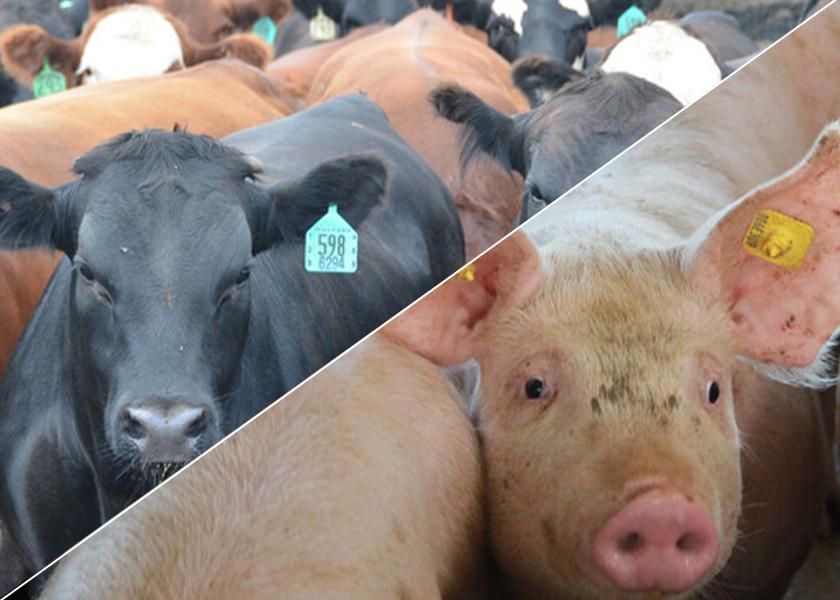Livestock Analysis | December 2, 2021

Price action: December lean hogs climbed 77.5 cents to $74.40, while most-active February rose $1.875 to $82.00, the highest closing price since Nov. 24.
Fundamental analysis: Resurgent wholesale pork prices and a rising lean hog index, along with strength in cattle, sparked a strong surge in hog futures. Wholesale weakness has seemingly acted as the Achilles heel for the hog market lately, with talk of a 6% annual reduction in winter hog supplies, advancing fed cattle values and the late-December futures move to a premium over the cash index, having only limited supportive impact on nearby futures. But today’s early jump in pork cutout values, which rose $8.40 to $89.30, seemed to trigger a strong bullish response.
The recent rally in December futures, which expire on December 14, to a significant premium over the CME Lean Hog Index (against which the futures contract settles), probably encouraged bulls, especially after the cash equivalent price turned higher yesterday (up 23 cents to $70.27). The preliminary figure for tomorrow rose 59 cents to $70.86. December futures’ close implies the index will rise another $4.13 over the next 11 days.
Cash hog prices may slip in late December, as the market often posts its annual low between Christmas and New Year’s Day. But we doubt the drop will be particularly large and expect a strong seasonal rebound, especially if early-2022 hog slaughter runs 6% under year-ago levels.
Technical analysis: The February contract’s inability to close above its 40-day moving average, now near $80.28, the past two days seemed to give bearish traders the technical advantage, but today’s bullish reversal flipped the script. The contract opened above that level and rebounded strongly after dipping to $78.95 at the daily low, which now marks secondary support. A drop below that level would have bears targeting the Nov. 10 low at $77.675.
Bulls proved unable to force a close significantly above the contract’s 10-day moving average near $82.06, making it likely initial resistance. A push above that level would probably face significant resistance around mid-November highs in the $83.50 area, then at the November high of $84.675.
What to do: Get current with feed advice.
Hedgers: You currently have all risk in the cash market.
Feed needs: You should have all soybean meal needs covered in the cash market through December. You are still hand-to-mouth on corn-for-feed needs.
Price action: Live cattle futures finished moderately to sharply higher. December live cattle firmed $1.65 to $137.65, while February futures gained 97.5 cents to $139.575. January feeder cattle finished 5 cents lower at $165.775, while deferred months were slightly firmer.
Fundamental analysis: Live cattle futures were supported by firmer cash cattle. Packers raised bids to $140 and then to $142 in the Southern Plains, with some feedlots reportedly moving cattle at the later level. Still others held out for even higher prices. The big discount December live cattle finished compared with today’s cash activity suggests traders are willing to take a wait-and-see approach. If those higher cash prices are confirmed, it would open additional upside potential in futures Friday.
Weekly U.S. beef export sales at 21,600 MT were up 12% from the previous week and 5% from the four-week average. South Korea was the lead buyer, but China was second on the list at 3,300 MT. Exports eased slightly from recent weeks but were still strong at 16,500 MT. Strong exports are compensating for sluggish domestic demand.
Boxed beef prices were firmer this morning, with Choice up $1.28 and Select 61 cents higher. Packers moved a solid 87 loads at the higher prices. But after a prolonged price slide, traders will want to see strong proof of improved retailer demand before they talk about a low.
Technical analysis: After topping action on the daily chart the first two days this week, February live cattle have bounced back and bulls still have the solid technical advantage, as the uptrend from the fall lows remains intact. Tuesday’s low at $137.35 is key near-term support as violation of that level would also break the uptrend and take out the 20-day moving average. Monday’s contract high at $141.85 is near-term resistance.
What to do: Get current with feed advice. Short-term protective hedges may be needed if this week’s lows are violated.
Hedgers: Carry all risk in the cash market for now.
Feed needs: You should have all soybean meal needs covered in the cash market through December. You are still hand-to-mouth on corn-for-feed needs.






